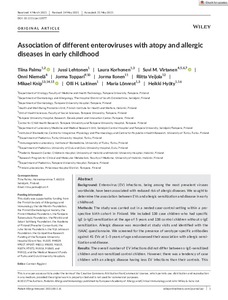Association of different enteroviruses with atopy and allergic diseases in early childhood
Laitinen Olli H; Palmu Tiina; Hyöty Heikki; Korhonen Laura; Veijola Riitta; Niemelä Onni; Knip Mikael; Lönnrot Maria; Lehtonen Jussi; Toppari Jorma; Ilonen Jorma; Virtanen Suvi M
https://urn.fi/URN:NBN:fi-fe2021093048377
Tiivistelmä
Background: Enterovirus (EV) infections, being among the most prevalent viruses worldwide, have been associated with reduced risk of allergic diseases. We sought to determine the association between EVs and allergic sensitization and disease in early childhood.
Methods: The study was carried out in a nested case-control setting within a prospective birth cohort in Finland. We included 138 case children who had specific IgE (s-IgE) sensitization at the age of 5 years and 138 control children without s-IgE sensitization. Allergic disease was recorded at study visits and identified with the ISAAC questionnaire. We screened for the presence of serotype-specific antibodies against 41 EVs at 1-5 years of age and assessed their association with allergic sensitization and disease.
Results: The overall number of EV infections did not differ between s-IgE-sensitized children and non-sensitized control children. However, there was a tendency of case children with an allergic disease having less EV infections than their controls. This observation was statistically significant for species A EVs in case children with atopic dermatitis vs. control children: OR 0.6 (95% CI 0.36-0.99), p = .048.
Conclusion: This study supports the evidence that EV exposure and development of allergic disease are inversely associated. Interestingly, the inverse association was not observed for bare atopic IgE sensitization, but for IgE sensitization coupled with clinical atopic disease. This suggests that environmental factors influencing IgE sensitization may differ from those influencing progression to clinical allergic disease.
Kokoelmat
- Rinnakkaistallenteet [19250]
